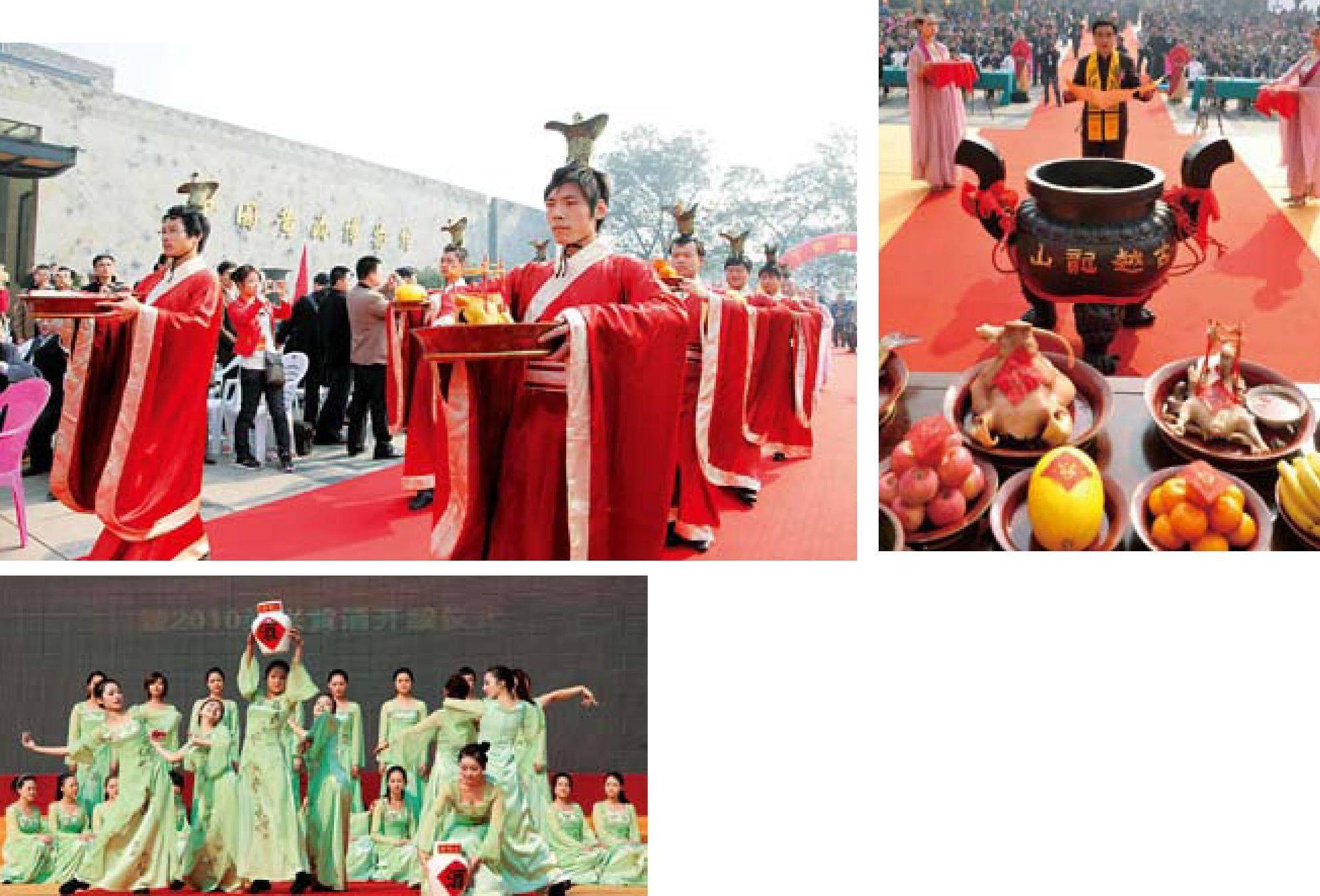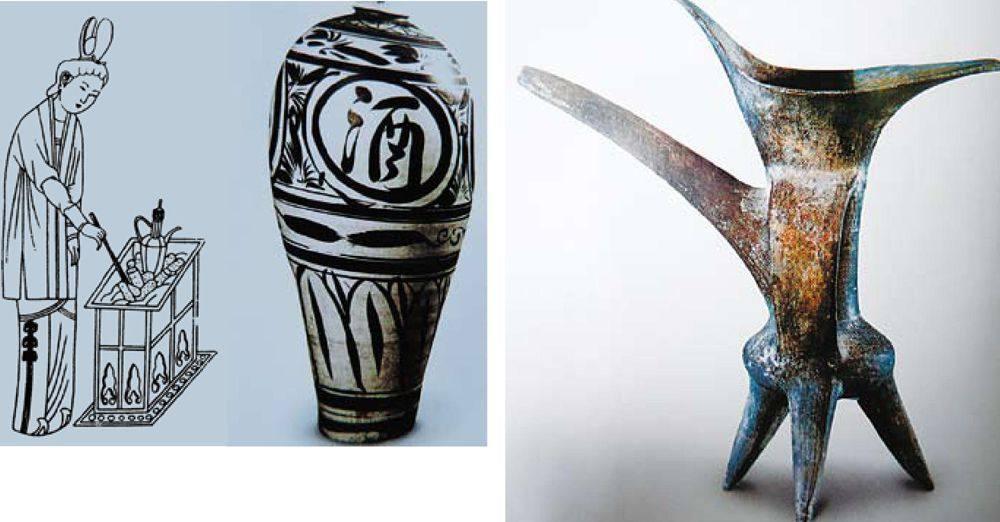黄酒文化韵醉天下
茹拥政



绍兴酒的世博情缘
在韩国丽水市举办的2012年世博会上,一款来自中国的古越龙山绍兴(花雕)酒吸引无数游客驻足。
这是一坛高50厘米、容量10公斤的古越龙山绍兴酒。“从一瓶酒可以追溯到田头的稻米、古代的酒具、名士的诗赋……”在世博会现场,展示方代表对黄酒充满独特文化魅力的介绍,令不少游客为之着迷。
黄酒起源于中国,与中华民族相依相随数千年。而黄酒中最有名的当数绍兴酒,它以选料上乘、工艺独特、酒精度低、营养丰富,并具有多种养身健体之功效而著称于世。黄酒起兴于唐代,定型于宋代,盛行于明清。名著《红楼梦》中就有许多饮绍兴黄酒的场面,贾府三日一小宴,五日一大宴,饮的多是黄酒。第六十三回上半回“寿怡红群芳开夜宴”中,袭人与平儿商议,“已经抬了一坛好绍兴酒藏在那边了”。这是大观园儿女皆可参加的盛宴,果然赴宴者都欢喜上这坛好酒,尽情畅饮,直至“酒缸已罄,众人听了,方收拾盥漱睡觉。”而清代著名食谱《调鼎集》则对绍兴黄酒的历史演变、品种和优良品质有全面的阐述。
绍兴酒第一次与世博结缘是在上个世纪初。1915年2月,为庆贺巴拿马运河开航,美国在旧金山举办“巴拿马太平洋万国博览会”,31个国家参展,中国也派出了庞大的代表团参展,绍兴酒首次参加这一国际盛会,并摘获一枚巴拿马太平洋万国博览会“金奖”。
时隔百年,2010年世博盛会在上海举行,绍兴黄酒再次进入世博会。为期一周的黄酒文化展示活动,包括展览、酒道表演、品鉴活动……向世人展示了黄酒深厚的文化底蕴与魅力。最有意思的是一坛为2010上海世博会量身定制的古越龙山佳酿还被抬上花轿,吹吹打打进入上海世博会中国馆,被中国馆永久珍藏。
2012年世博会5月12日至8月12日在韩国丽水市举行,这是继上海世博会后的第一个专业性世博会。位于朝鲜半岛东南端的丽水市是韩国最美丽的口岸城市之一,也是绍兴市的友好城市。1997年5月21日,绍兴市与丽水市正式签约建立友好交流关系,10多年来两地交往不断深入,丽水市曾派代表参加绍兴黄酒节等活动。
此次韩国丽水世博会期间,“丽水馆”特地为友好城市绍兴开辟一个展区,于是也成就了绍兴酒和2012年韩国世博会的一段情缘。
“从上海世博会到韩国世博会,是绍兴黄酒的品牌之旅”。古越龙山绍兴酒股份有限公司负责人表示,与参加1915年巴拿马太平洋万国博览会时相比,今天的黄酒在酿造工艺、口感以及包装上,既传承古老文化,又接轨国际潮流。
祭酒神与制佳酿
在绍兴,有两场祭祀盛典非常值得一看,一是谷雨时节祭祀大禹,二是立冬时节祭祀酒神。
每年的谷雨,绍兴都会举行隆重的公祭大禹陵典礼。祭祀仪式十分讲究,采用古代最高礼祭—“谛礼”形式进行,共分肃立雅静、鸣铳、献供品、敬香、击鼓、撞钟、奏乐、献酒、敬酒、恭读祭文、行礼、唱颂歌、献祭舞13项仪程。
绍兴从1995年起恢复公祭大禹陵典礼活动。为表达对大禹的崇敬,当时古越龙山捐资百万修建了大禹陵牌坊,并拿出百年陈酿公祭大禹陵。当琥珀色的醇酒倒入酒爵时,扑鼻酒香弥漫了整个大禹陵,国内外好多媒体都作了报道,引起了轰动。据在祭祀现场的人回忆,那一坛百年陈酿真是香啊!
这坛百年陈酿,可以说是国内保存历史最长的黄酒,酿制于1928年,是古越龙山前身—一个老酒坊酿造的。上个世纪50年代拆建仓库时被发现,存放在瓦房里,约有百余坛,用特制的大型陶坛盛装,最小的有40公斤重,最大的有60公斤重。开坛时,酒液只剩下三分之二左右。酒坛泥盖里还存放标有1928年酿制的坊单,是手写的。这些酒被当作“镇厂之宝”加以悉心存放。
绍兴的另一个重要祭祀是立冬时节祭祀酒神。绍兴酒生产有明显的季节性,从立冬开始到第二年立春,这段时间最适合做黄酒,称为“冬酿”。因为冬季水体清洌、气温低,可有效抑制杂菌繁育,确保发酵顺利进行,又能使酒在低温长时间发酵过程中形成良好的风味。立冬是酿酒发酵最适合的季节,也是绍兴酒投料开酿的日子。
对酒神的尊崇其实深埋在每一个酿酒师傅的内心。由于黄酒是敞开式发酵,多菌种共酵,酿制工艺比较复杂也比较神秘,稍有把握不当,酿出的酒味道容易发酸。所以在从前,不管是寻常人家还是大小酒坊,在每年立冬开酿之时,为祈求能酿出好酒,都会举行一个祭拜仪式:一般选在开酿这一天的早上,天蒙蒙亮的时候,打开酿酒间的所有门窗,摆上五牲四果、三茶六酒,点燃香烛,然后大家轮流祭拜酒神。正像一位酿酒师傅所说:“祭拜过酒神后,我的心才会觉得踏实,才会自信满满地开始这一冬酿季节的生产。”
独特的稽山鉴水与千年精湛工艺酿造出中国黄酒的完美滋味。
国礼与诗酒艺文
绍兴黄酒1988年起被定为国宴酒,而且屡被选为国家领导人赠送外国元首或领导人的礼品。
1985年9月,邓小平与来华访问的美国总统尼克松在家共进午餐,尼克松喝了绍兴酒大加赞赏。宾主欣然握别时,邓小平遂赠其“古越龙山”加饭酒4瓶,并祝他旅途愉快,身体健康。1998年6月,美国总统克林顿访华,作为国礼赠送总统的是100多坛十年陈绍兴花雕,坛上塑有天女散花等图案,并刻有“美国总统克林顿访华纪念”字样。
绍兴酒还是周恩来总理与柬埔寨王国元首诺罗敦·西哈努克亲王友谊的见证。在周总理的热情推荐下,亲王亦对绍兴酒情有独钟。亲王偕夫人莫尼克公主两次访问绍兴,都曾亲临绍兴酿酒总厂参观,并说:“周恩来总理生前曾要我有机会到绍兴酒厂看一看,尝一尝。今天我终于得偿夙愿!”
绍兴酒又称老酒,越陈越香;越陈,味越醇。
据传,古时有一裁缝婚后多年无子,后因妻子有孕而喜不自胜。他酿酒数坛,以备生子庆贺,不料临盆竟是女孩,再无心绪酒宴,遂将酿成之酒埋入院中。孰知女儿越长越聪慧俊俏,至18岁,更是人见人爱,说亲者接踵。裁缝不忍爱女远嫁,即让女儿与自己的得意徒弟成亲。人逢喜事,裁缝忽然想起18年前埋下的酒,便小心翼翼挖将出来。不料甏盖一开,竟然奇香袭人。品尝少许,则口感绵柔醇厚,余味无穷。裁缝大喜过望,遂开坛大宴乡亲。有询之究竟者,裁缝随口答曰:“女儿红。”
自此,绍兴酒竟成了女儿必备的陪嫁。“女儿红”以其特有的温馨和无穷的寄情空间,不仅醉了秉性柔婉的江南才子佳人,而且能在醺醺然的氛围中让北方的豪士侠女醉在越地文化的柔美之中。
绍兴十三年(1153)陆游赴临安应考,在绍兴沈园与前妻唐琬邂逅。接过唐琬敬酒,陆游痛饮不已,百感交集便索笔挥毫,在沈园壁间题书千古绝唱《钗头凤》一阕:
红酥手,黄縢酒,满城春色宫墙柳。
东风恶,欢情薄,一怀愁绪,几年离索。
错、错、错!
……
今年5月,乐坛著名词人方文山有感于古越龙山黄酒的醇美,特意作了一阕词。词中有这样的文句:
“鉴湖岸、溢酒香,绍兴佳酿、佐蟹黄。”
“一壶一碗一举觞,酒是中国黄。
—茶一汤一过往,故事我浅尝。
古越凭龙山,我举杯,品无双。
曲水流觞,兰亭对饮击掌。
这天地微醺,我独酌梦江南。”
古往今来,吟咏、描绘绍兴黄酒的诗词文赋、佚闻逸事、戏曲书画数不胜数,以绍兴黄酒为题材的诸如《女儿红》等影视作品更是可圈可点,从中可见黄酒文化源远流长,底蕴特别深厚。
Yellow Wine: A Tasteful Cultural Phenomenon
By Ru Yongzheng
In September 1985, ex-president of America Richard Nixon visited China. At a home banquet hosted by Deng Xiaoping, Nixon and Deng sipped yellow wine made in Shaoxing, a historical city in eastern Zhejiang Province. Nixon enjoyed the wine very much. After the banquet, Deng gave four bottles of yellow wine in the brand of Gu Yue Long Shan as gift to Nixon. When American President Clinton visited China in June 1998, he received more than100 jars of 10-year vintage yellow wine of Shaoxing as state gifts from China.
Yellow wine, also known as Shaoxing wine or rice wine, is almost another name of Shaoxing, although rice wine is brewed in many places across the southern part of China. Rice wine is several thousand years old. The best known is the wine produced in Shaoxing.
It is said that people in Shaoxing began to brew yellow wine in the Tang Dynasty (618-907). In the Song Dynasty, it became well known and in the following centuries, the reputation became widespread across the nation.
In “The Dream of Red Mansion”, a timeless novel of Chinese literature written during the Qing Dynasty (1644-1911), there are descriptions about banquets in which yellow wine is served. A book on food and wine written in the Qing Dynasty has a comprehensive description of the evolution, brands, quality of the yellow wine made in Shaoxing.
In 1915, the Panama–Pacific International Exposition was held in San Francisco, the United States. Thirty-one nations participated. Of the exhibits showcased by China was the yellow wine made in Shaoxing. The wine was awarded a gold medal at the exposition.
Shaoxing displayed its yellow wine at the 2010 Shanghai World Expo. A jar of yellow wine tailor-made in Shaoxing for the expo was escorted into the China Pavilion with all the fanfare. The jar of yellow wine is now in the permanent collection of the national pavilion.
Yellow wine made in Shaoxing also had a remarkable time at 2012 World Expo Yeosu Korea. Shaoxing and Yeosu became sister cities in May 1997. Over the past 10 plus years, the two cities have been engaged in promoting friendship through mutual visits and other programs. At the 2012 Expo Yeosu Korea, the Yeosu Pavilion assigned a space for Shaoxing to display its wine. The exhibit was a 50-centimeter-tall jar of ten-kilogram yellow wine.
Sacrificial Ceremonies in Shaoxing
Nowadays Shaoxing holds two important annual public ceremonies. One is to honor Yu the Great at the Yu Mausoleum, a legendary emperor who brought prehistoric floods under control. The great emperor was buried in Shaoxing, hence the mausoleum. The other is to honor the god of wine at the beginning of the annual wine-brewing season.
In 1995, Shaoxing resumed the public sacrificial ceremony at the Yu Mausoleum. At the 1995 ceremony, Gu Yu Long Shan, a major wine maker in Shaoxing, donated one million yuan to restore the memorial archway at the mausoleum. The wine brewer also donated a jar of vintage yellow wine for the sacrifice. When the jar was opened at the ceremony and the wine was being poured into ancient-styled wine cups, the aroma of the wine wafted, causing a huge sensation. Many who attended the ceremony in 1995 fondly remember the permeating aroma at the sacrifice.
The vintage wine came from a secret wine vault discovered in a screen wall in the 1950s when some construction workers were dismantling a warehouse. They discovered about 100 pottery jars of yellow wine. The weight of these jars varies, some about 40 kilograms heavy and some about 60 kilograms. A jar was opened; in the sealant earth on the opening of the jar was a workshop record form indicating that the wine was brewed in 1928. These huge jars of yellow wine are now cherished as the brewers most important treasure.
The other important public sacrificial ceremony in Shaoxing is the sacrifice in honor of the god of wine at the beginning of winter, a solar term that falls on early December. The period between the beginning of winter and the beginning of spring is the brewing season in Shaoxing largely because water quality and temperature are especial suitable for wine to mature.
As yellow wine making is a complicated process and wine may go wrong if any detail in the long process is amiss. Nowadays, a wine brewing process takes 100 days including 20 plus steps and 5 key procedures before it matures. So brewers, no matter whether they are factory-size brewers, workshop-sized brewers or home brewers, hold a sacrificial ceremony to seek blessing from the god of wine. The important ceremony is complex. Many brewers say that they become confident to begin a years work only after the ceremony is properly performed.

